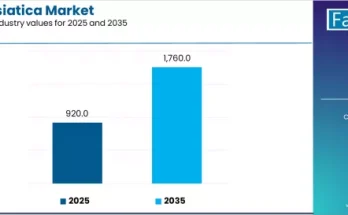The artificial sweetener market is gaining strong traction as consumers increasingly shift toward calorie-conscious lifestyles and healthier dietary habits. With rising concerns over sugar intake, obesity, diabetes, and overall metabolic health, food and beverage manufacturers are embracing alternative sweetening solutions that offer the taste of sugar without the added calories. Artificial sweeteners have become integral to modern food formulations, powering innovations across beverages, processed foods, pharmaceuticals, and personal nutrition products.
As awareness regarding low-calorie diets grows and demand for sugar substitutes expands across global markets, artificial sweeteners are playing a transformative role in shaping the future of “better-for-you” food products. Their stability, versatility, and cost-effectiveness make them essential for brands catering to health-focused consumers.
Market Overview:
The artificial sweetener market includes a variety of non-nutritive sweetening agents used to reduce sugar content while maintaining taste and sweetness levels. These include aspartame, sucralose, saccharin, acesulfame potassium, neotame, and other advanced formulations designed for specific industrial and household applications.
Major factors driving the market include:
- Increasing consumer preference for low-calorie and sugar-free diet options
- Rising incidence of lifestyle disorders such as diabetes and obesity
- Expansion of low-sugar and zero-sugar product lines in the food and beverage industry
- Growing demand for cost-effective sweetening alternatives with high stability and long shelf life
Artificial sweeteners provide several advantages such as heat stability, easy solubility, and intense sweetness levels, making them ideal for baked goods, beverages, snacks, dairy alternatives, pharmaceuticals, and sports nutrition products.
Regional Insights:
North America:
North America remains one of the leading markets for artificial sweeteners due to strong consumer demand for diet beverages, low-sugar snacks, and functional foods. The region’s health-driven consumer base, combined with regulatory approvals for various sweeteners, supports market expansion. Major food and beverage companies in the region continue to invest in sugar-reduction technologies and new product innovations.
Europe:
Europe shows significant adoption of artificial sweeteners, supported by strict food standards and growing awareness of sugar-related health issues. Low-calorie sweeteners are widely used in confectionery, beverages, and bakery products. Increased focus on clean-label products and sugar taxes in several countries is pushing manufacturers to reformulate using alternative sweetening agents.
Asia-Pacific:
Asia-Pacific is witnessing rapid growth in artificial sweetener consumption due to rising urbanization, increasing disposable incomes, and growing demand for convenient, processed foods. The popularity of diet beverages and health supplements is accelerating market expansion. Additionally, the region is emerging as a strong manufacturing hub for artificial sweeteners, offering competitive production advantages.
Latin America, Middle East & Africa:
Other regions are adopting artificial sweeteners as awareness about low-sugar diets grows and more consumers turn to health-focused food choices. Increasing penetration of multinational food brands and rising prevalence of diabetes are strengthening market demand.
Key Trends & Forecast:
The artificial sweetener market is evolving rapidly with emerging trends influencing product development, regulatory approaches, and consumer preferences.
- Rising Popularity of Sugar-Free and Low-Calorie Food Products
Consumers are increasingly demanding sugar-free beverages, confectionery, breakfast products, and ready-to-eat meals. Manufacturers are responding by formulating products with artificial sweeteners to meet health and wellness expectations.
- Innovation in Blended Sweeteners
Food manufacturers are increasingly utilizing blends of artificial sweeteners to achieve improved taste profiles and reduced aftertastes. These blends mimic sugar sweetness more closely and are becoming popular in premium formulations.
- Growing Demand in Pharmaceuticals and Nutritional Supplements
Artificial sweeteners are essential in the pharmaceutical sector for coating tablets, syrups, chewable medicines, and oral care products. Their use in sports nutrition, protein powders, and meal replacement shakes is also rising significantly.
- Expanding Retail Availability
Artificial sweeteners are increasingly available in powder, tablet, and liquid formats across supermarkets, pharmacies, and online platforms. This accessibility is supporting household adoption of sugar substitutes.
- Regulatory Support and Approvals
Food safety authorities worldwide have approved several types of artificial sweeteners, promoting confidence among manufacturers and consumers. Regulatory clarity is enabling companies to invest in research and product development.
- Increased Use in Foodservice and Beverage Industries
Restaurants, cafés, fast-food chains, and beverage companies are incorporating artificial sweeteners to meet customer preferences for low-calorie menu options. The booming café culture and growing consumption of soft drinks and flavored beverages support this trend.
Applications & End-Use Outlook:
Artificial sweeteners are used across a wide range of applications due to their intense sweetness and functional benefits.
Food & Beverages:
This segment holds the largest share of artificial sweetener applications. They are commonly used in:
- Diet soft drinks and flavored beverages
- Sugar-free bakery products
- Confectionery items
- Dairy alternatives and flavored yogurts
- Breakfast cereals and health snacks
Pharmaceuticals:
Artificial sweeteners enhance the palatability of medicinal syrups, chewable tablets, and oral solutions. Their non-caloric nature makes them suitable for pediatric and diabetic formulations.
Nutraceuticals:
They are widely used in protein shakes, sports nutrition products, powdered supplements, and weight-management solutions.
Household Consumption:
Artificial sweeteners in powder and tablet form are commonly used as sugar substitutes for tea, coffee, and home cooking.
Foodservice Sector:
Restaurants and cafés use artificial sweeteners to cater to health-conscious customers seeking low-calorie dining options.
Conclusion:
The artificial sweetener market is playing a pivotal role in reshaping global dietary trends as consumers seek healthier alternatives to traditional sugar. Their versatility, affordability, and effectiveness in reducing calorie intake make artificial sweeteners an essential ingredient across food, beverages, pharmaceuticals, and nutrition products.
As demand for low-sugar diets continues to rise, the market is poised for steady expansion driven by innovation, regulatory support, and evolving consumer preferences. Companies adopting artificial sweeteners can unlock new opportunities by prioritizing taste optimization, clean-label formulations, and transparent communication. Accessing comprehensive market insights is essential for businesses looking to navigate this growing and highly dynamic industry.
Browse Full Report – https://www.factmr.com/report/2313/artificial-sweetener-market



